Economics Report: Analyzing Economic Scenarios in Malta
VerifiedAdded on 2022/12/30
|20
|5391
|219
Report
AI Summary
This economics report provides an analysis of several economic scenarios in Malta. It begins by defining demand and supply, distinguishing between movements and shifts in the demand function using hygiene products as an example, and illustrating the impact of the COVID-19 pandemic on equilibrium prices. The report then examines the operations of Airmalta, differentiating between short and long-run perspectives, identifying fixed and variable costs, and discussing the airline's market structure and financial performance. Furthermore, the report defines inflation, explains demand-pull and cost-push inflation, and identifies methods for measuring inflation. Finally, it differentiates between GDP and GNP, explains the expenditure method for measuring GDP, and analyzes economic growth rates, including real and nominal growth, and the impact of the COVID-19 pandemic on these rates. The report concludes with an overview of the key findings across all scenarios.
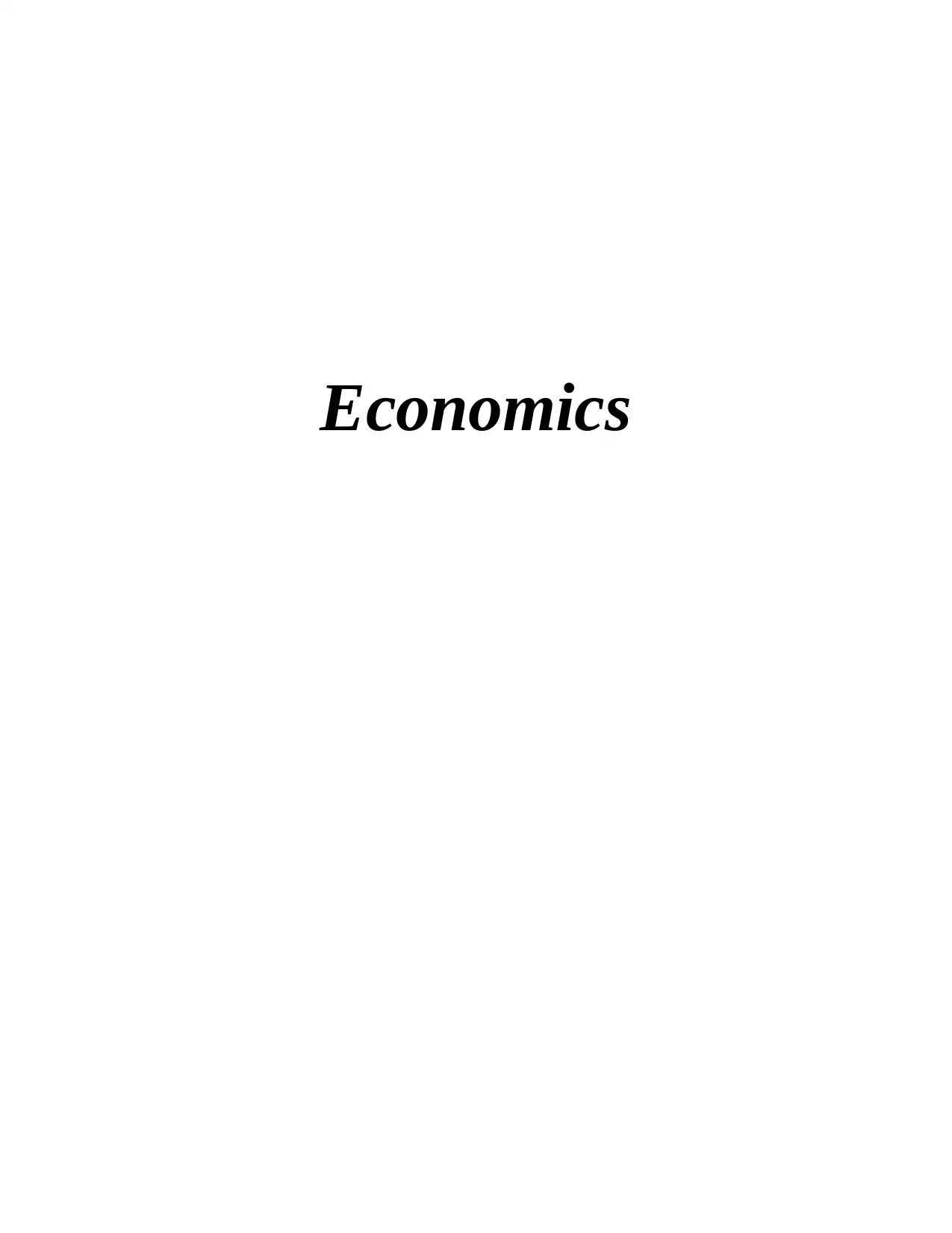
Economics
Paraphrase This Document
Need a fresh take? Get an instant paraphrase of this document with our AI Paraphraser
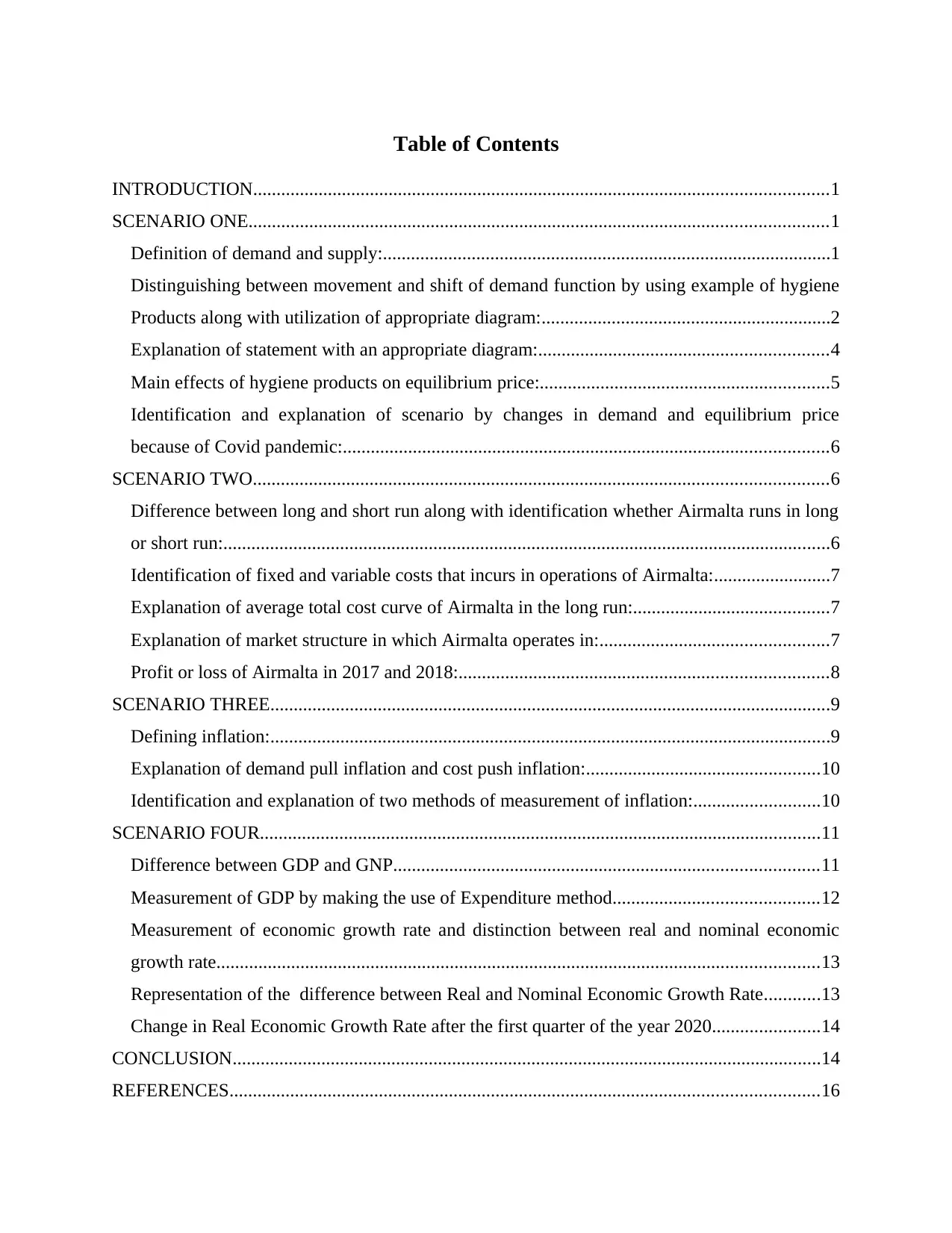
Table of Contents
INTRODUCTION...........................................................................................................................1
SCENARIO ONE............................................................................................................................1
Definition of demand and supply:................................................................................................1
Distinguishing between movement and shift of demand function by using example of hygiene
Products along with utilization of appropriate diagram:..............................................................2
Explanation of statement with an appropriate diagram:..............................................................4
Main effects of hygiene products on equilibrium price:..............................................................5
Identification and explanation of scenario by changes in demand and equilibrium price
because of Covid pandemic:........................................................................................................6
SCENARIO TWO...........................................................................................................................6
Difference between long and short run along with identification whether Airmalta runs in long
or short run:..................................................................................................................................6
Identification of fixed and variable costs that incurs in operations of Airmalta:.........................7
Explanation of average total cost curve of Airmalta in the long run:..........................................7
Explanation of market structure in which Airmalta operates in:.................................................7
Profit or loss of Airmalta in 2017 and 2018:...............................................................................8
SCENARIO THREE........................................................................................................................9
Defining inflation:........................................................................................................................9
Explanation of demand pull inflation and cost push inflation:..................................................10
Identification and explanation of two methods of measurement of inflation:...........................10
SCENARIO FOUR........................................................................................................................11
Difference between GDP and GNP...........................................................................................11
Measurement of GDP by making the use of Expenditure method............................................12
Measurement of economic growth rate and distinction between real and nominal economic
growth rate.................................................................................................................................13
Representation of the difference between Real and Nominal Economic Growth Rate............13
Change in Real Economic Growth Rate after the first quarter of the year 2020.......................14
CONCLUSION..............................................................................................................................14
REFERENCES..............................................................................................................................16
INTRODUCTION...........................................................................................................................1
SCENARIO ONE............................................................................................................................1
Definition of demand and supply:................................................................................................1
Distinguishing between movement and shift of demand function by using example of hygiene
Products along with utilization of appropriate diagram:..............................................................2
Explanation of statement with an appropriate diagram:..............................................................4
Main effects of hygiene products on equilibrium price:..............................................................5
Identification and explanation of scenario by changes in demand and equilibrium price
because of Covid pandemic:........................................................................................................6
SCENARIO TWO...........................................................................................................................6
Difference between long and short run along with identification whether Airmalta runs in long
or short run:..................................................................................................................................6
Identification of fixed and variable costs that incurs in operations of Airmalta:.........................7
Explanation of average total cost curve of Airmalta in the long run:..........................................7
Explanation of market structure in which Airmalta operates in:.................................................7
Profit or loss of Airmalta in 2017 and 2018:...............................................................................8
SCENARIO THREE........................................................................................................................9
Defining inflation:........................................................................................................................9
Explanation of demand pull inflation and cost push inflation:..................................................10
Identification and explanation of two methods of measurement of inflation:...........................10
SCENARIO FOUR........................................................................................................................11
Difference between GDP and GNP...........................................................................................11
Measurement of GDP by making the use of Expenditure method............................................12
Measurement of economic growth rate and distinction between real and nominal economic
growth rate.................................................................................................................................13
Representation of the difference between Real and Nominal Economic Growth Rate............13
Change in Real Economic Growth Rate after the first quarter of the year 2020.......................14
CONCLUSION..............................................................................................................................14
REFERENCES..............................................................................................................................16

⊘ This is a preview!⊘
Do you want full access?
Subscribe today to unlock all pages.

Trusted by 1+ million students worldwide
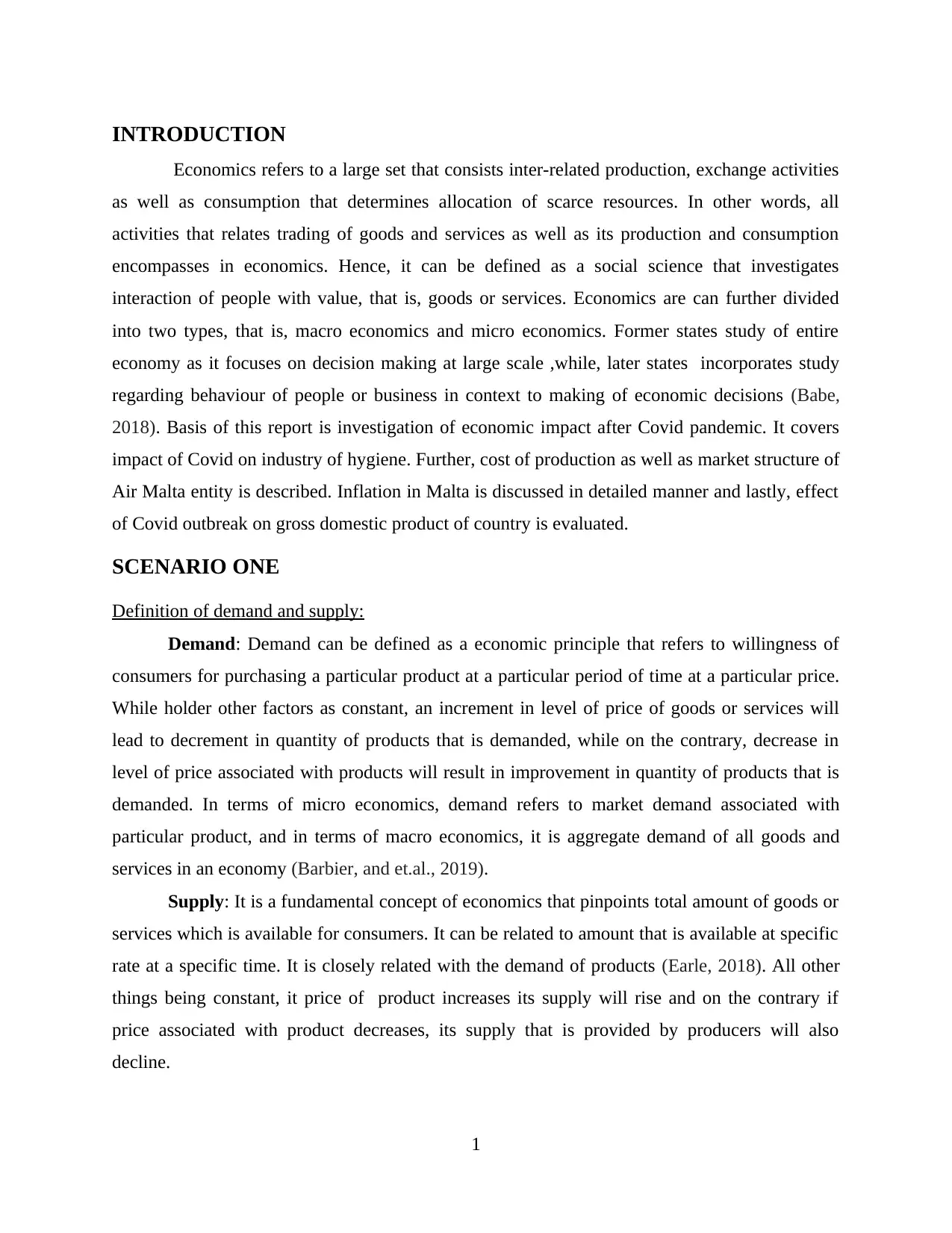
INTRODUCTION
Economics refers to a large set that consists inter-related production, exchange activities
as well as consumption that determines allocation of scarce resources. In other words, all
activities that relates trading of goods and services as well as its production and consumption
encompasses in economics. Hence, it can be defined as a social science that investigates
interaction of people with value, that is, goods or services. Economics are can further divided
into two types, that is, macro economics and micro economics. Former states study of entire
economy as it focuses on decision making at large scale ,while, later states incorporates study
regarding behaviour of people or business in context to making of economic decisions (Babe,
2018). Basis of this report is investigation of economic impact after Covid pandemic. It covers
impact of Covid on industry of hygiene. Further, cost of production as well as market structure of
Air Malta entity is described. Inflation in Malta is discussed in detailed manner and lastly, effect
of Covid outbreak on gross domestic product of country is evaluated.
SCENARIO ONE
Definition of demand and supply:
Demand: Demand can be defined as a economic principle that refers to willingness of
consumers for purchasing a particular product at a particular period of time at a particular price.
While holder other factors as constant, an increment in level of price of goods or services will
lead to decrement in quantity of products that is demanded, while on the contrary, decrease in
level of price associated with products will result in improvement in quantity of products that is
demanded. In terms of micro economics, demand refers to market demand associated with
particular product, and in terms of macro economics, it is aggregate demand of all goods and
services in an economy (Barbier, and et.al., 2019).
Supply: It is a fundamental concept of economics that pinpoints total amount of goods or
services which is available for consumers. It can be related to amount that is available at specific
rate at a specific time. It is closely related with the demand of products (Earle, 2018). All other
things being constant, it price of product increases its supply will rise and on the contrary if
price associated with product decreases, its supply that is provided by producers will also
decline.
1
Economics refers to a large set that consists inter-related production, exchange activities
as well as consumption that determines allocation of scarce resources. In other words, all
activities that relates trading of goods and services as well as its production and consumption
encompasses in economics. Hence, it can be defined as a social science that investigates
interaction of people with value, that is, goods or services. Economics are can further divided
into two types, that is, macro economics and micro economics. Former states study of entire
economy as it focuses on decision making at large scale ,while, later states incorporates study
regarding behaviour of people or business in context to making of economic decisions (Babe,
2018). Basis of this report is investigation of economic impact after Covid pandemic. It covers
impact of Covid on industry of hygiene. Further, cost of production as well as market structure of
Air Malta entity is described. Inflation in Malta is discussed in detailed manner and lastly, effect
of Covid outbreak on gross domestic product of country is evaluated.
SCENARIO ONE
Definition of demand and supply:
Demand: Demand can be defined as a economic principle that refers to willingness of
consumers for purchasing a particular product at a particular period of time at a particular price.
While holder other factors as constant, an increment in level of price of goods or services will
lead to decrement in quantity of products that is demanded, while on the contrary, decrease in
level of price associated with products will result in improvement in quantity of products that is
demanded. In terms of micro economics, demand refers to market demand associated with
particular product, and in terms of macro economics, it is aggregate demand of all goods and
services in an economy (Barbier, and et.al., 2019).
Supply: It is a fundamental concept of economics that pinpoints total amount of goods or
services which is available for consumers. It can be related to amount that is available at specific
rate at a specific time. It is closely related with the demand of products (Earle, 2018). All other
things being constant, it price of product increases its supply will rise and on the contrary if
price associated with product decreases, its supply that is provided by producers will also
decline.
1
Paraphrase This Document
Need a fresh take? Get an instant paraphrase of this document with our AI Paraphraser
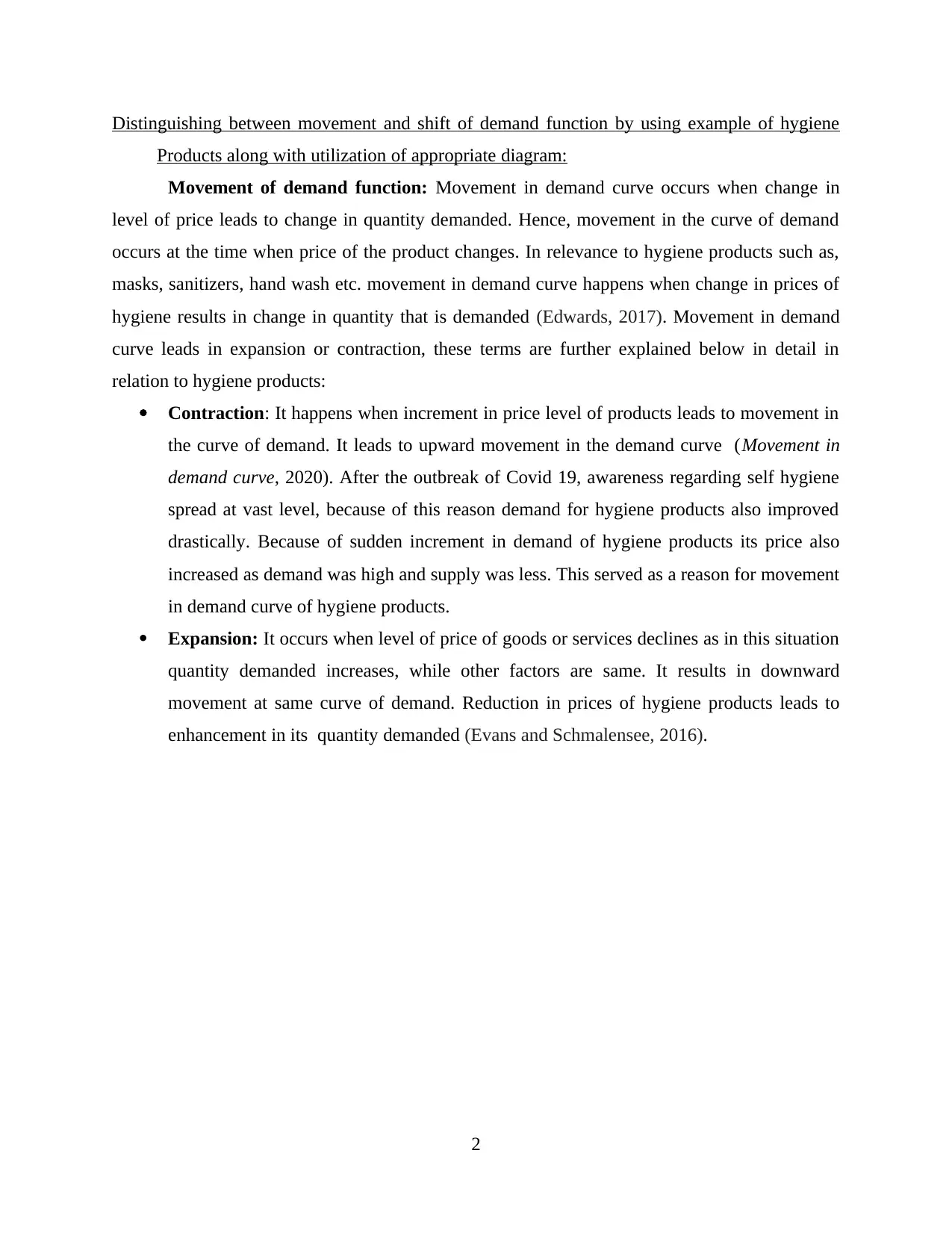
Distinguishing between movement and shift of demand function by using example of hygiene
Products along with utilization of appropriate diagram:
Movement of demand function: Movement in demand curve occurs when change in
level of price leads to change in quantity demanded. Hence, movement in the curve of demand
occurs at the time when price of the product changes. In relevance to hygiene products such as,
masks, sanitizers, hand wash etc. movement in demand curve happens when change in prices of
hygiene results in change in quantity that is demanded (Edwards, 2017). Movement in demand
curve leads in expansion or contraction, these terms are further explained below in detail in
relation to hygiene products:
Contraction: It happens when increment in price level of products leads to movement in
the curve of demand. It leads to upward movement in the demand curve (Movement in
demand curve, 2020). After the outbreak of Covid 19, awareness regarding self hygiene
spread at vast level, because of this reason demand for hygiene products also improved
drastically. Because of sudden increment in demand of hygiene products its price also
increased as demand was high and supply was less. This served as a reason for movement
in demand curve of hygiene products.
Expansion: It occurs when level of price of goods or services declines as in this situation
quantity demanded increases, while other factors are same. It results in downward
movement at same curve of demand. Reduction in prices of hygiene products leads to
enhancement in its quantity demanded (Evans and Schmalensee, 2016).
2
Products along with utilization of appropriate diagram:
Movement of demand function: Movement in demand curve occurs when change in
level of price leads to change in quantity demanded. Hence, movement in the curve of demand
occurs at the time when price of the product changes. In relevance to hygiene products such as,
masks, sanitizers, hand wash etc. movement in demand curve happens when change in prices of
hygiene results in change in quantity that is demanded (Edwards, 2017). Movement in demand
curve leads in expansion or contraction, these terms are further explained below in detail in
relation to hygiene products:
Contraction: It happens when increment in price level of products leads to movement in
the curve of demand. It leads to upward movement in the demand curve (Movement in
demand curve, 2020). After the outbreak of Covid 19, awareness regarding self hygiene
spread at vast level, because of this reason demand for hygiene products also improved
drastically. Because of sudden increment in demand of hygiene products its price also
increased as demand was high and supply was less. This served as a reason for movement
in demand curve of hygiene products.
Expansion: It occurs when level of price of goods or services declines as in this situation
quantity demanded increases, while other factors are same. It results in downward
movement at same curve of demand. Reduction in prices of hygiene products leads to
enhancement in its quantity demanded (Evans and Schmalensee, 2016).
2
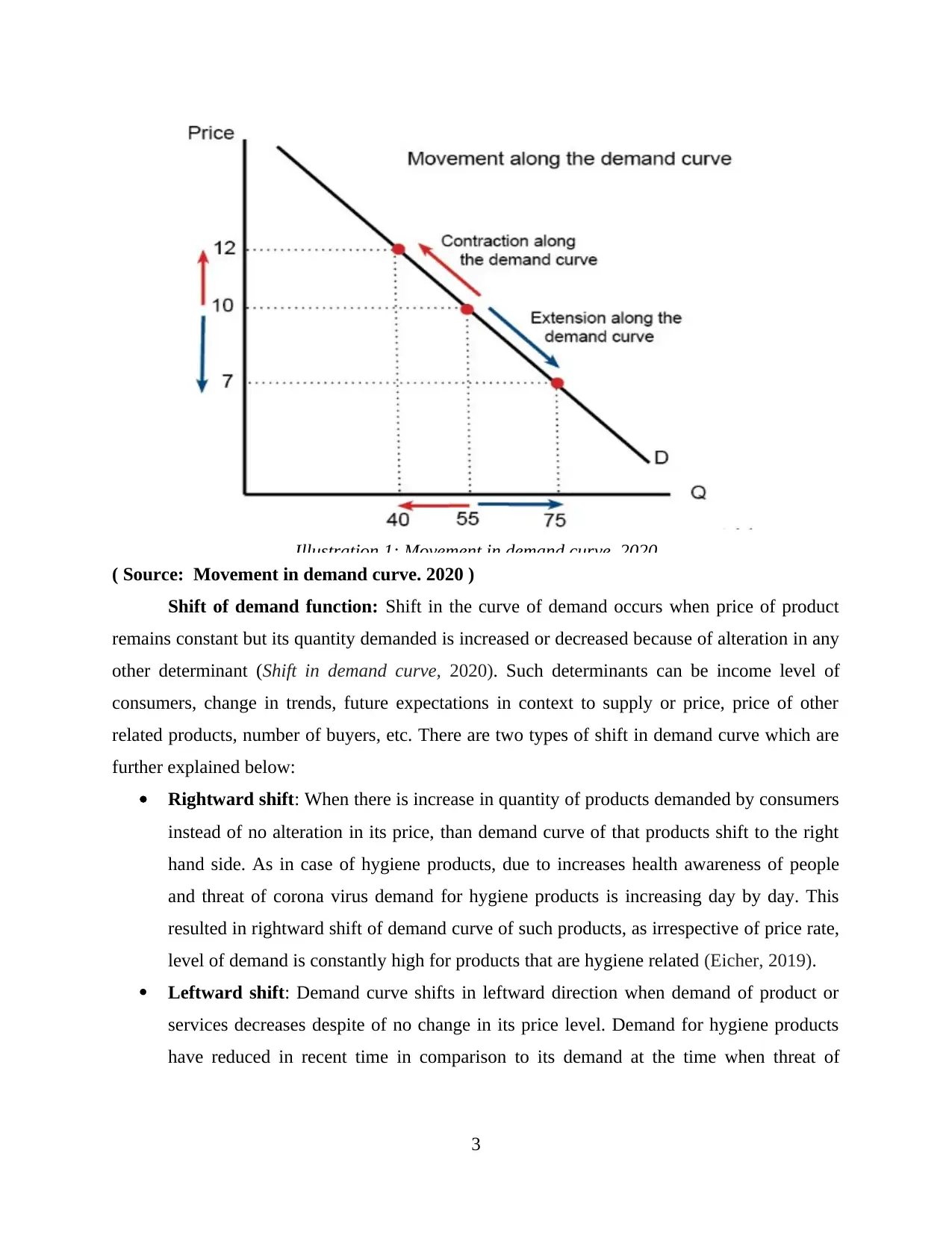
Illustration 1: Movement in demand curve. 2020
( Source: Movement in demand curve. 2020 )
Shift of demand function: Shift in the curve of demand occurs when price of product
remains constant but its quantity demanded is increased or decreased because of alteration in any
other determinant (Shift in demand curve, 2020). Such determinants can be income level of
consumers, change in trends, future expectations in context to supply or price, price of other
related products, number of buyers, etc. There are two types of shift in demand curve which are
further explained below:
Rightward shift: When there is increase in quantity of products demanded by consumers
instead of no alteration in its price, than demand curve of that products shift to the right
hand side. As in case of hygiene products, due to increases health awareness of people
and threat of corona virus demand for hygiene products is increasing day by day. This
resulted in rightward shift of demand curve of such products, as irrespective of price rate,
level of demand is constantly high for products that are hygiene related (Eicher, 2019).
Leftward shift: Demand curve shifts in leftward direction when demand of product or
services decreases despite of no change in its price level. Demand for hygiene products
have reduced in recent time in comparison to its demand at the time when threat of
3
( Source: Movement in demand curve. 2020 )
Shift of demand function: Shift in the curve of demand occurs when price of product
remains constant but its quantity demanded is increased or decreased because of alteration in any
other determinant (Shift in demand curve, 2020). Such determinants can be income level of
consumers, change in trends, future expectations in context to supply or price, price of other
related products, number of buyers, etc. There are two types of shift in demand curve which are
further explained below:
Rightward shift: When there is increase in quantity of products demanded by consumers
instead of no alteration in its price, than demand curve of that products shift to the right
hand side. As in case of hygiene products, due to increases health awareness of people
and threat of corona virus demand for hygiene products is increasing day by day. This
resulted in rightward shift of demand curve of such products, as irrespective of price rate,
level of demand is constantly high for products that are hygiene related (Eicher, 2019).
Leftward shift: Demand curve shifts in leftward direction when demand of product or
services decreases despite of no change in its price level. Demand for hygiene products
have reduced in recent time in comparison to its demand at the time when threat of
3
⊘ This is a preview!⊘
Do you want full access?
Subscribe today to unlock all pages.

Trusted by 1+ million students worldwide
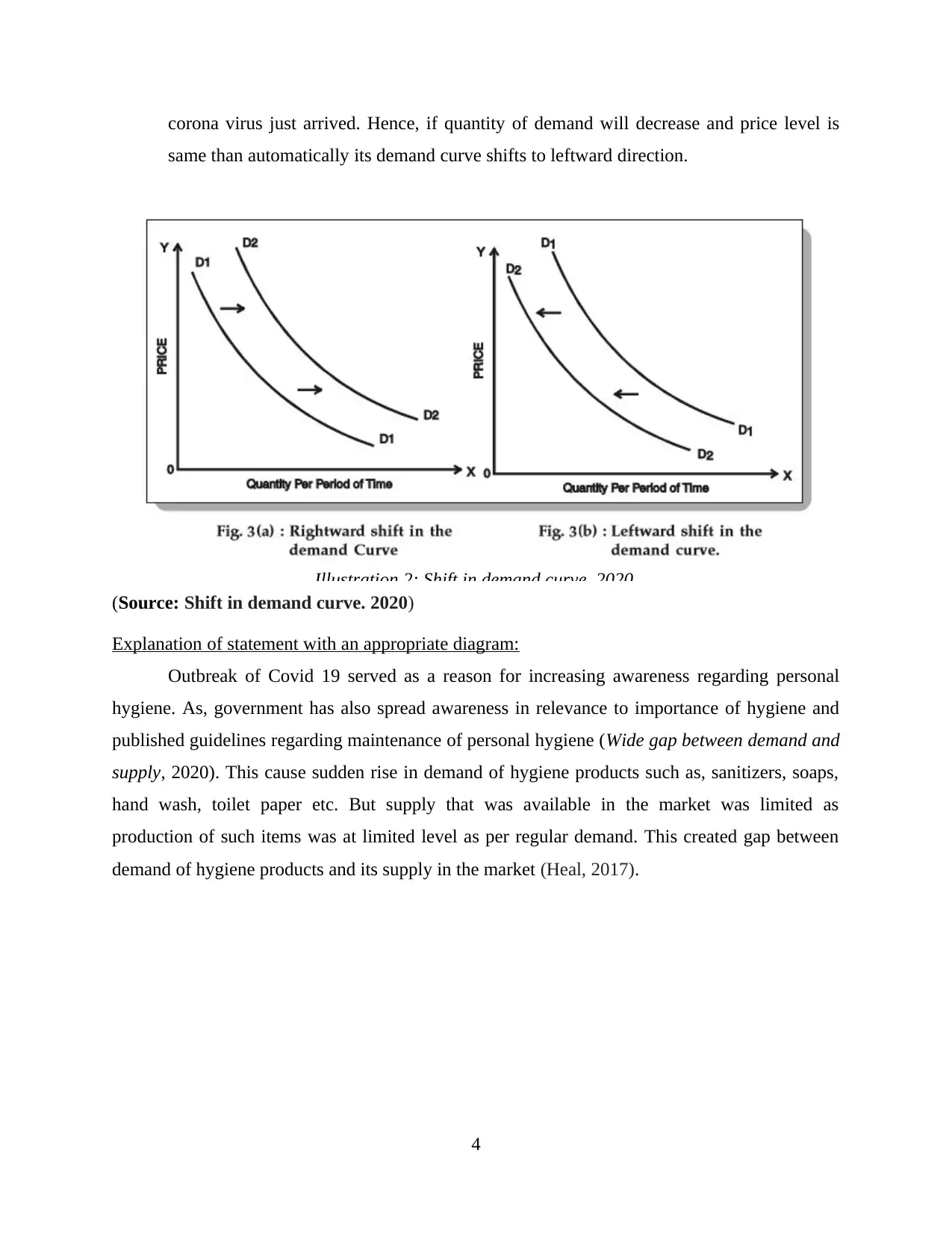
corona virus just arrived. Hence, if quantity of demand will decrease and price level is
same than automatically its demand curve shifts to leftward direction.
Illustration 2: Shift in demand curve. 2020.
(Source: Shift in demand curve. 2020)
Explanation of statement with an appropriate diagram:
Outbreak of Covid 19 served as a reason for increasing awareness regarding personal
hygiene. As, government has also spread awareness in relevance to importance of hygiene and
published guidelines regarding maintenance of personal hygiene (Wide gap between demand and
supply, 2020). This cause sudden rise in demand of hygiene products such as, sanitizers, soaps,
hand wash, toilet paper etc. But supply that was available in the market was limited as
production of such items was at limited level as per regular demand. This created gap between
demand of hygiene products and its supply in the market (Heal, 2017).
4
same than automatically its demand curve shifts to leftward direction.
Illustration 2: Shift in demand curve. 2020.
(Source: Shift in demand curve. 2020)
Explanation of statement with an appropriate diagram:
Outbreak of Covid 19 served as a reason for increasing awareness regarding personal
hygiene. As, government has also spread awareness in relevance to importance of hygiene and
published guidelines regarding maintenance of personal hygiene (Wide gap between demand and
supply, 2020). This cause sudden rise in demand of hygiene products such as, sanitizers, soaps,
hand wash, toilet paper etc. But supply that was available in the market was limited as
production of such items was at limited level as per regular demand. This created gap between
demand of hygiene products and its supply in the market (Heal, 2017).
4
Paraphrase This Document
Need a fresh take? Get an instant paraphrase of this document with our AI Paraphraser
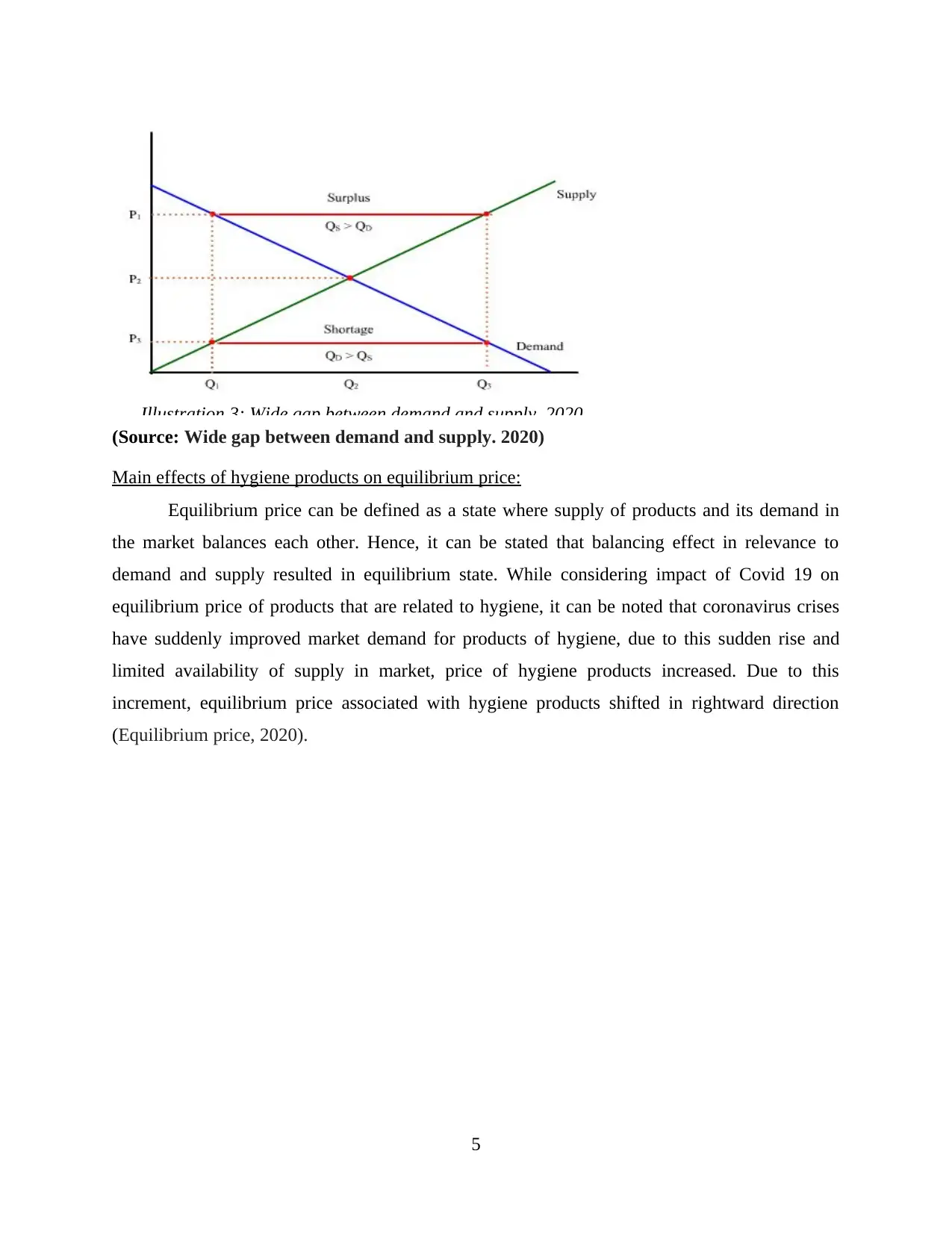
Illustration 3: Wide gap between demand and supply. 2020
(Source: Wide gap between demand and supply. 2020)
Main effects of hygiene products on equilibrium price:
Equilibrium price can be defined as a state where supply of products and its demand in
the market balances each other. Hence, it can be stated that balancing effect in relevance to
demand and supply resulted in equilibrium state. While considering impact of Covid 19 on
equilibrium price of products that are related to hygiene, it can be noted that coronavirus crises
have suddenly improved market demand for products of hygiene, due to this sudden rise and
limited availability of supply in market, price of hygiene products increased. Due to this
increment, equilibrium price associated with hygiene products shifted in rightward direction
(Equilibrium price, 2020).
5
(Source: Wide gap between demand and supply. 2020)
Main effects of hygiene products on equilibrium price:
Equilibrium price can be defined as a state where supply of products and its demand in
the market balances each other. Hence, it can be stated that balancing effect in relevance to
demand and supply resulted in equilibrium state. While considering impact of Covid 19 on
equilibrium price of products that are related to hygiene, it can be noted that coronavirus crises
have suddenly improved market demand for products of hygiene, due to this sudden rise and
limited availability of supply in market, price of hygiene products increased. Due to this
increment, equilibrium price associated with hygiene products shifted in rightward direction
(Equilibrium price, 2020).
5
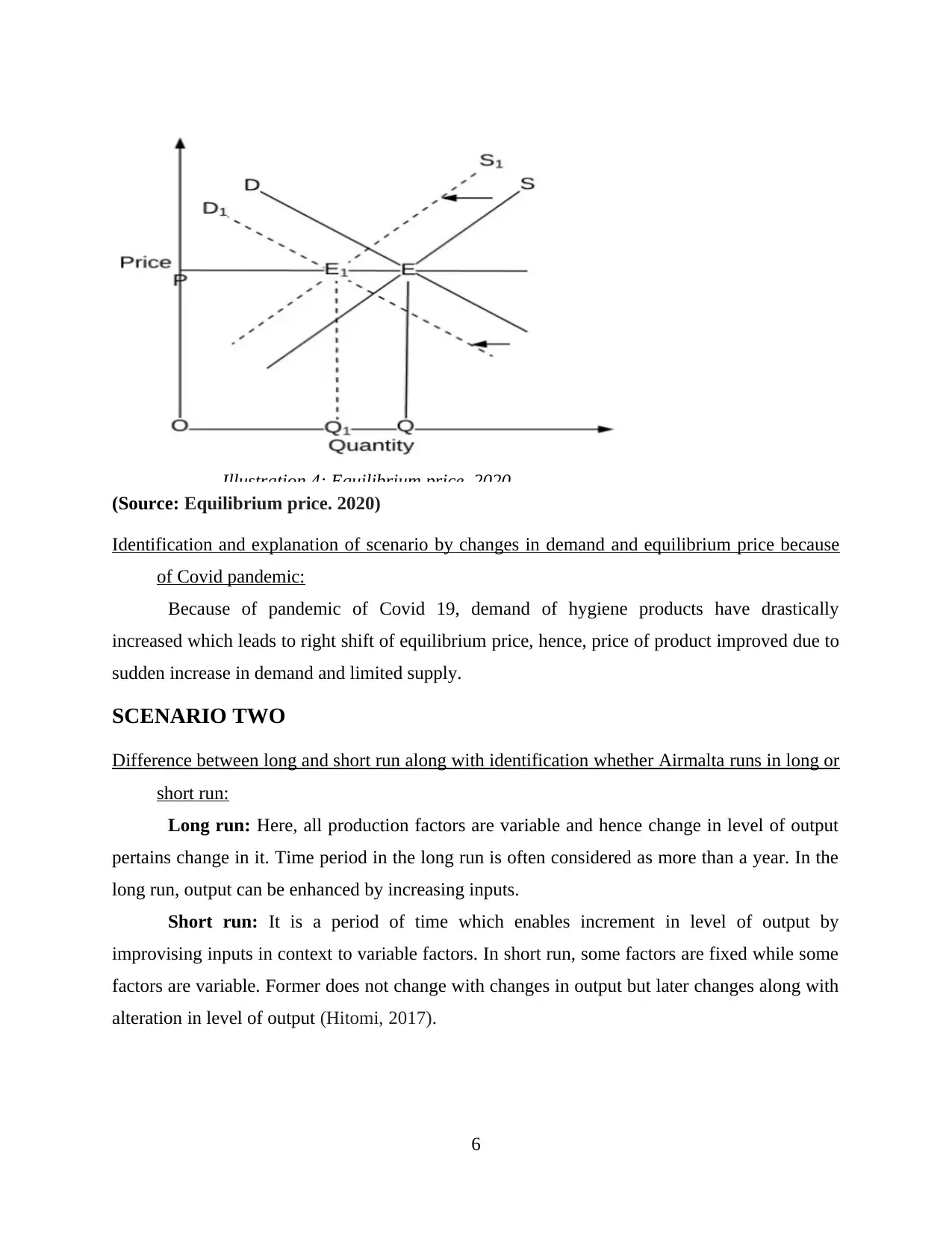
Illustration 4: Equilibrium price. 2020.
(Source: Equilibrium price. 2020)
Identification and explanation of scenario by changes in demand and equilibrium price because
of Covid pandemic:
Because of pandemic of Covid 19, demand of hygiene products have drastically
increased which leads to right shift of equilibrium price, hence, price of product improved due to
sudden increase in demand and limited supply.
SCENARIO TWO
Difference between long and short run along with identification whether Airmalta runs in long or
short run:
Long run: Here, all production factors are variable and hence change in level of output
pertains change in it. Time period in the long run is often considered as more than a year. In the
long run, output can be enhanced by increasing inputs.
Short run: It is a period of time which enables increment in level of output by
improvising inputs in context to variable factors. In short run, some factors are fixed while some
factors are variable. Former does not change with changes in output but later changes along with
alteration in level of output (Hitomi, 2017).
6
(Source: Equilibrium price. 2020)
Identification and explanation of scenario by changes in demand and equilibrium price because
of Covid pandemic:
Because of pandemic of Covid 19, demand of hygiene products have drastically
increased which leads to right shift of equilibrium price, hence, price of product improved due to
sudden increase in demand and limited supply.
SCENARIO TWO
Difference between long and short run along with identification whether Airmalta runs in long or
short run:
Long run: Here, all production factors are variable and hence change in level of output
pertains change in it. Time period in the long run is often considered as more than a year. In the
long run, output can be enhanced by increasing inputs.
Short run: It is a period of time which enables increment in level of output by
improvising inputs in context to variable factors. In short run, some factors are fixed while some
factors are variable. Former does not change with changes in output but later changes along with
alteration in level of output (Hitomi, 2017).
6
⊘ This is a preview!⊘
Do you want full access?
Subscribe today to unlock all pages.

Trusted by 1+ million students worldwide
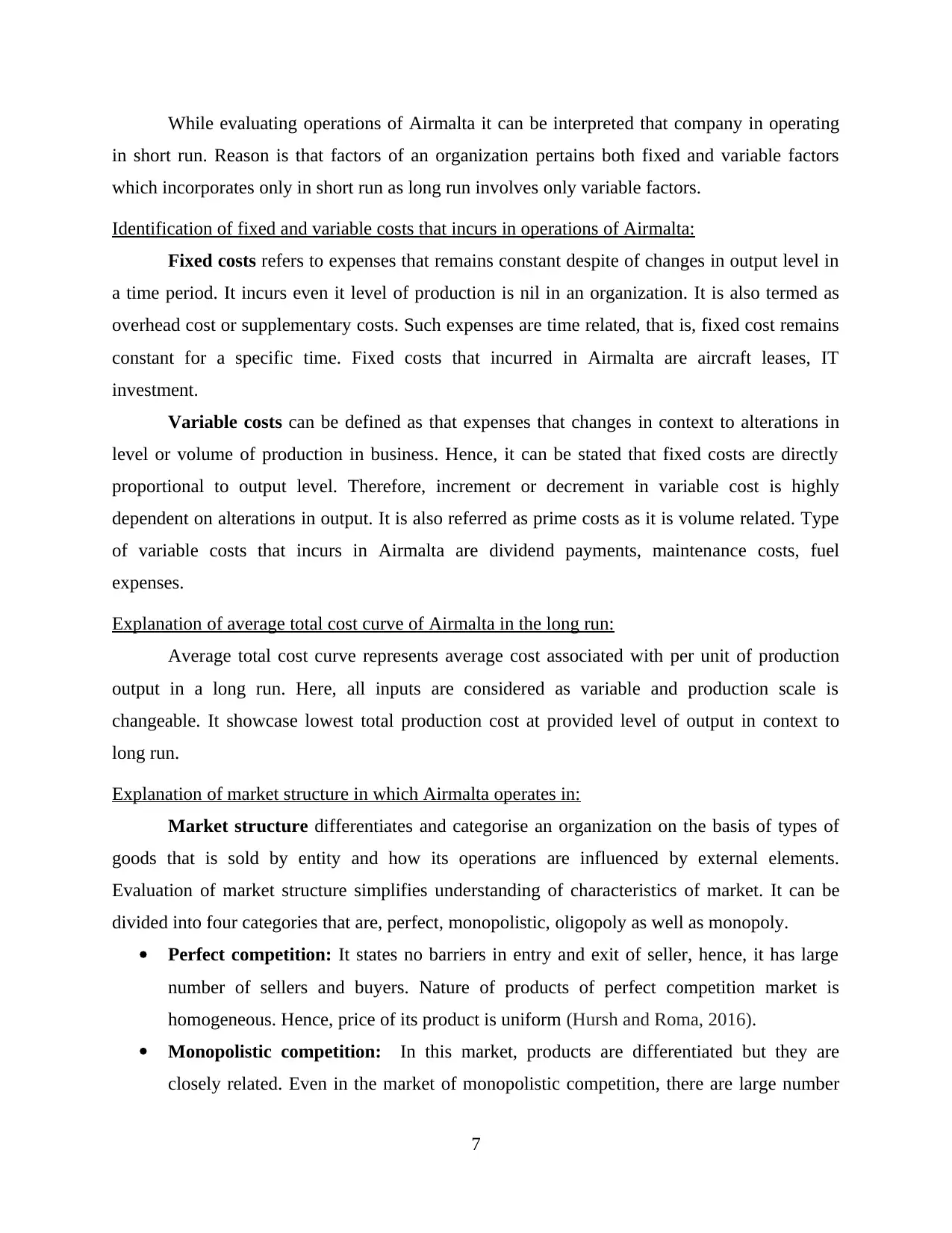
While evaluating operations of Airmalta it can be interpreted that company in operating
in short run. Reason is that factors of an organization pertains both fixed and variable factors
which incorporates only in short run as long run involves only variable factors.
Identification of fixed and variable costs that incurs in operations of Airmalta:
Fixed costs refers to expenses that remains constant despite of changes in output level in
a time period. It incurs even it level of production is nil in an organization. It is also termed as
overhead cost or supplementary costs. Such expenses are time related, that is, fixed cost remains
constant for a specific time. Fixed costs that incurred in Airmalta are aircraft leases, IT
investment.
Variable costs can be defined as that expenses that changes in context to alterations in
level or volume of production in business. Hence, it can be stated that fixed costs are directly
proportional to output level. Therefore, increment or decrement in variable cost is highly
dependent on alterations in output. It is also referred as prime costs as it is volume related. Type
of variable costs that incurs in Airmalta are dividend payments, maintenance costs, fuel
expenses.
Explanation of average total cost curve of Airmalta in the long run:
Average total cost curve represents average cost associated with per unit of production
output in a long run. Here, all inputs are considered as variable and production scale is
changeable. It showcase lowest total production cost at provided level of output in context to
long run.
Explanation of market structure in which Airmalta operates in:
Market structure differentiates and categorise an organization on the basis of types of
goods that is sold by entity and how its operations are influenced by external elements.
Evaluation of market structure simplifies understanding of characteristics of market. It can be
divided into four categories that are, perfect, monopolistic, oligopoly as well as monopoly.
Perfect competition: It states no barriers in entry and exit of seller, hence, it has large
number of sellers and buyers. Nature of products of perfect competition market is
homogeneous. Hence, price of its product is uniform (Hursh and Roma, 2016).
Monopolistic competition: In this market, products are differentiated but they are
closely related. Even in the market of monopolistic competition, there are large number
7
in short run. Reason is that factors of an organization pertains both fixed and variable factors
which incorporates only in short run as long run involves only variable factors.
Identification of fixed and variable costs that incurs in operations of Airmalta:
Fixed costs refers to expenses that remains constant despite of changes in output level in
a time period. It incurs even it level of production is nil in an organization. It is also termed as
overhead cost or supplementary costs. Such expenses are time related, that is, fixed cost remains
constant for a specific time. Fixed costs that incurred in Airmalta are aircraft leases, IT
investment.
Variable costs can be defined as that expenses that changes in context to alterations in
level or volume of production in business. Hence, it can be stated that fixed costs are directly
proportional to output level. Therefore, increment or decrement in variable cost is highly
dependent on alterations in output. It is also referred as prime costs as it is volume related. Type
of variable costs that incurs in Airmalta are dividend payments, maintenance costs, fuel
expenses.
Explanation of average total cost curve of Airmalta in the long run:
Average total cost curve represents average cost associated with per unit of production
output in a long run. Here, all inputs are considered as variable and production scale is
changeable. It showcase lowest total production cost at provided level of output in context to
long run.
Explanation of market structure in which Airmalta operates in:
Market structure differentiates and categorise an organization on the basis of types of
goods that is sold by entity and how its operations are influenced by external elements.
Evaluation of market structure simplifies understanding of characteristics of market. It can be
divided into four categories that are, perfect, monopolistic, oligopoly as well as monopoly.
Perfect competition: It states no barriers in entry and exit of seller, hence, it has large
number of sellers and buyers. Nature of products of perfect competition market is
homogeneous. Hence, price of its product is uniform (Hursh and Roma, 2016).
Monopolistic competition: In this market, products are differentiated but they are
closely related. Even in the market of monopolistic competition, there are large number
7
Paraphrase This Document
Need a fresh take? Get an instant paraphrase of this document with our AI Paraphraser

of buyers and sellers as it incorporates no barriers on entry and exit. It pertains partial
control over rate or price of products.
Monopoly: In this type of market structure, there is a single seller of a unique product in
a market. Product do not even have any closed substitute. Hence, no competition is faced
by business that operates in monopoly market as it pertains barrier on entry and exit of
seller. Products that are offered in this market are differentiated and sole entity is a price
maker in it.
Oligopoly: This market structure incorporates small number of organizations . Hence,
buyers are large but sellers are few. Products that are offered in oligopoly market can be
homogeneous or differentiated. There is price rigidity in this market because of threat of
price war.
While evaluating market structure of Airmalta it can be identified that company is
operating in oligopoly market structure. As company operates in aviation industry which
incorporates limited number of large players. Reason is that aviation industry requires high
capital investment, high fixed expenditures and provides thin profit margin.
Profit or loss of Airmalta in 2017 and 2018:
8
control over rate or price of products.
Monopoly: In this type of market structure, there is a single seller of a unique product in
a market. Product do not even have any closed substitute. Hence, no competition is faced
by business that operates in monopoly market as it pertains barrier on entry and exit of
seller. Products that are offered in this market are differentiated and sole entity is a price
maker in it.
Oligopoly: This market structure incorporates small number of organizations . Hence,
buyers are large but sellers are few. Products that are offered in oligopoly market can be
homogeneous or differentiated. There is price rigidity in this market because of threat of
price war.
While evaluating market structure of Airmalta it can be identified that company is
operating in oligopoly market structure. As company operates in aviation industry which
incorporates limited number of large players. Reason is that aviation industry requires high
capital investment, high fixed expenditures and provides thin profit margin.
Profit or loss of Airmalta in 2017 and 2018:
8
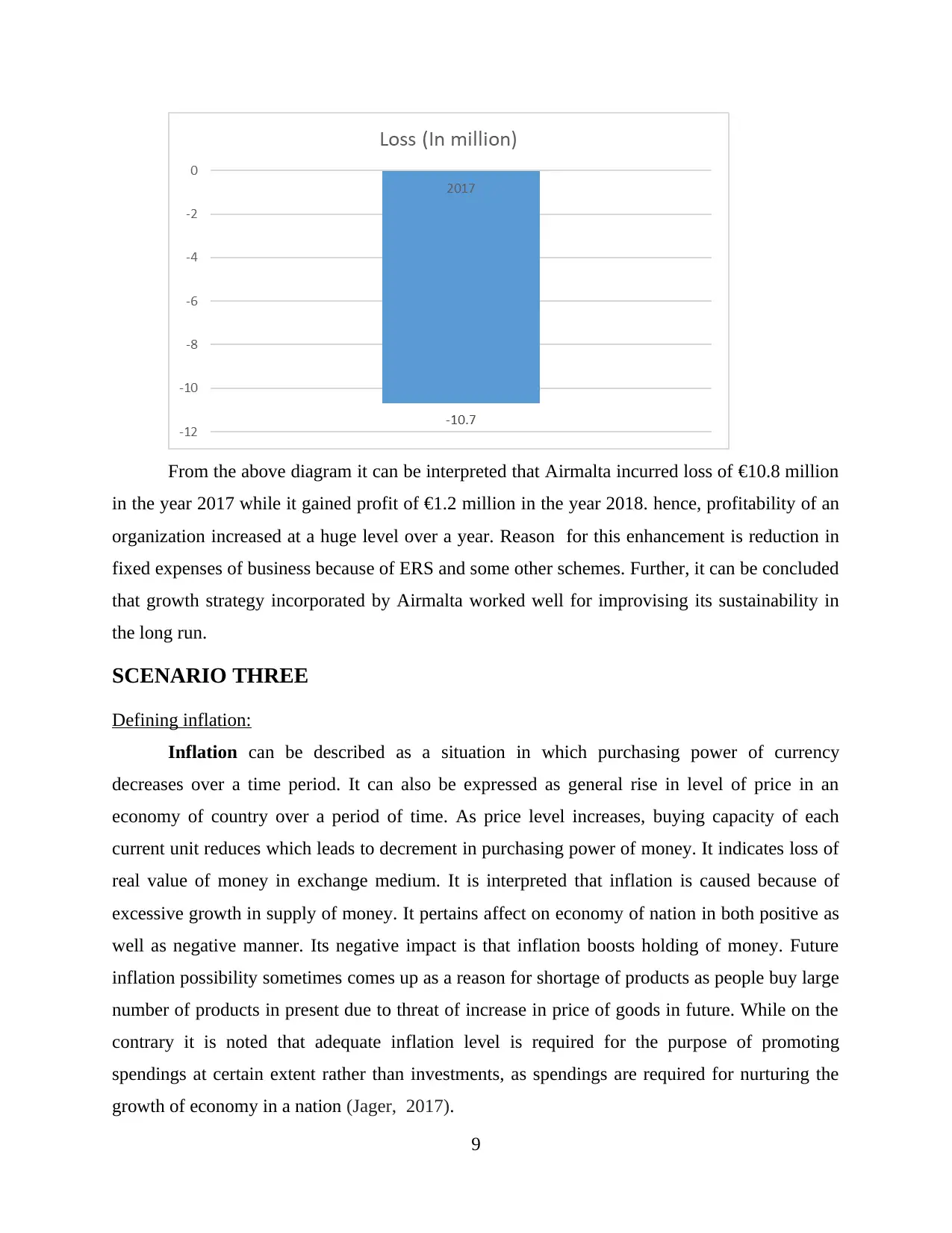
From the above diagram it can be interpreted that Airmalta incurred loss of €10.8 million
in the year 2017 while it gained profit of €1.2 million in the year 2018. hence, profitability of an
organization increased at a huge level over a year. Reason for this enhancement is reduction in
fixed expenses of business because of ERS and some other schemes. Further, it can be concluded
that growth strategy incorporated by Airmalta worked well for improvising its sustainability in
the long run.
SCENARIO THREE
Defining inflation:
Inflation can be described as a situation in which purchasing power of currency
decreases over a time period. It can also be expressed as general rise in level of price in an
economy of country over a period of time. As price level increases, buying capacity of each
current unit reduces which leads to decrement in purchasing power of money. It indicates loss of
real value of money in exchange medium. It is interpreted that inflation is caused because of
excessive growth in supply of money. It pertains affect on economy of nation in both positive as
well as negative manner. Its negative impact is that inflation boosts holding of money. Future
inflation possibility sometimes comes up as a reason for shortage of products as people buy large
number of products in present due to threat of increase in price of goods in future. While on the
contrary it is noted that adequate inflation level is required for the purpose of promoting
spendings at certain extent rather than investments, as spendings are required for nurturing the
growth of economy in a nation (Jager, 2017).
9
in the year 2017 while it gained profit of €1.2 million in the year 2018. hence, profitability of an
organization increased at a huge level over a year. Reason for this enhancement is reduction in
fixed expenses of business because of ERS and some other schemes. Further, it can be concluded
that growth strategy incorporated by Airmalta worked well for improvising its sustainability in
the long run.
SCENARIO THREE
Defining inflation:
Inflation can be described as a situation in which purchasing power of currency
decreases over a time period. It can also be expressed as general rise in level of price in an
economy of country over a period of time. As price level increases, buying capacity of each
current unit reduces which leads to decrement in purchasing power of money. It indicates loss of
real value of money in exchange medium. It is interpreted that inflation is caused because of
excessive growth in supply of money. It pertains affect on economy of nation in both positive as
well as negative manner. Its negative impact is that inflation boosts holding of money. Future
inflation possibility sometimes comes up as a reason for shortage of products as people buy large
number of products in present due to threat of increase in price of goods in future. While on the
contrary it is noted that adequate inflation level is required for the purpose of promoting
spendings at certain extent rather than investments, as spendings are required for nurturing the
growth of economy in a nation (Jager, 2017).
9
⊘ This is a preview!⊘
Do you want full access?
Subscribe today to unlock all pages.

Trusted by 1+ million students worldwide
1 out of 20
Related Documents
Your All-in-One AI-Powered Toolkit for Academic Success.
+13062052269
info@desklib.com
Available 24*7 on WhatsApp / Email
![[object Object]](/_next/static/media/star-bottom.7253800d.svg)
Unlock your academic potential
Copyright © 2020–2026 A2Z Services. All Rights Reserved. Developed and managed by ZUCOL.





